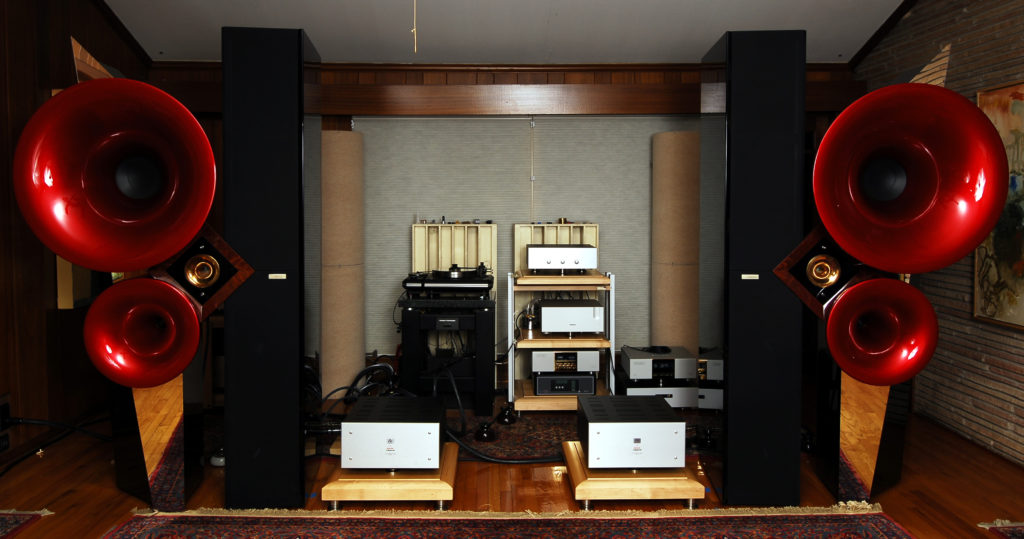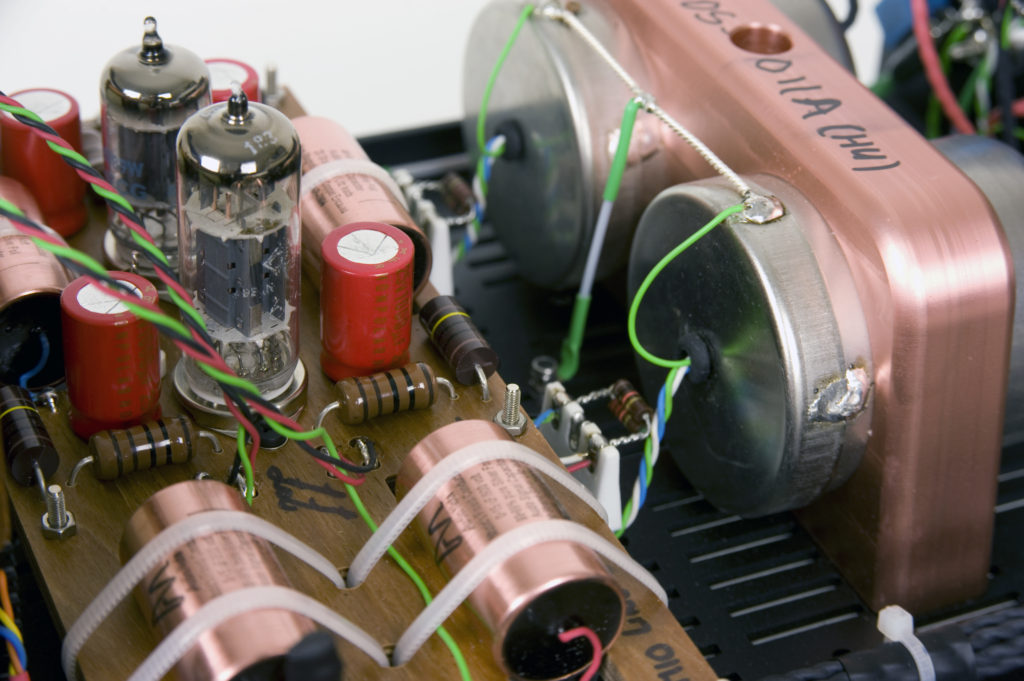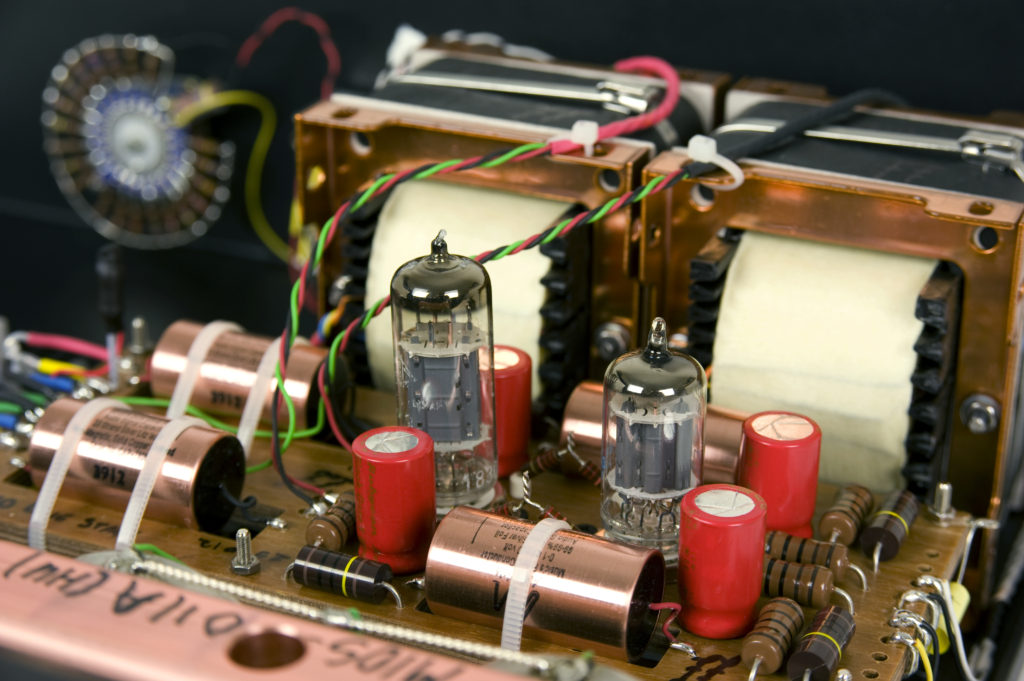
System: Acapella Audio Arts Triolon Excalibur speakers, Rockport Sirius turntable, EMM Labs TX2 SACD transport, EMM Labs DA2, Audio Note M10 Signature preamplifier, Audio Note Kegon Balanced monoblocks (M10 Galahad PSU on separate stand)*
Changing Power Cords
Normally, I would not even consider tweaks to a new piece of equipment until relatively sure that the unit was broken in; however, in this case, Audio Note had been kind enough to provide me with two different power cords for the M10 Signature, an Isis, which is their latest all copper cord, and a silver Sogon. So I decided to experiment back and forth one evening while two of my more astute listening buddies were over helping evaluate the gear. As it turned out, the copper and silver power cords were quite different sonically. The silver was, at least for my tastes, a bit soft and romantic in the highs, seeming to smooth things out, though at the same time overall (comparatively) missing body in the midrange and lows. The copper was more linear, bringing out more information from the low bass through the midrange, which rounded out both the individual instruments and the whole tonal and spatial picture. The only downside with the Isis was a bit more edge at times – in this sense occasionally telling us (to varying degrees, depending upon taste) perhaps more than some would like to know about the artifacts of the recording process. While all three of us ultimately preferred the fully fleshed midrange and bass of the copper, certainly access to the two very different cords does allow the listener some flexibility in tailoring the sound.
Finally We Have Lift Off
Regular readers will know that I generally have a preference for vinyl as opposed to digital sources – although that is becoming a closer call as digital continues to improve, and in my own case, particularly with the introduction of the EMM DA2/TX2 processor/transport to the system, which presents digital recordings in an outstanding way. Still, original analog recordings, and even early digital recordings, most often come to life more effectively in their original vinyl medium. Consequently, I and my listening team were thrilled on the day that we were able to re-introduce the Rockport to the system. What I will discuss now are some of our observations of some very pleasant LP listening.
“Everything But the Girl,” The Language of Life (produced by the late Tommy LiPuma). At its best, pop music, from a sonic perspective, involves an effort on the part of the producer and, one hopes, the artist, to create a new sound. This involves artifice enabled by technology … but artifice nonetheless. Sometimes, the resolution capacity of our gear will outpace the music, exposing the artifice, and in doing so, ruin it for us. This can be a particularly tough issue dealing with music of the relatively early days of digital, as with the 1990’s The Language of Life, a collaboration of LiPuma with Ben Watt and Tracy Thorn, collectively known by the rather curious moniker of Everything But the Girl. This was one of the last pop records to come out on vinyl after the ascendance of digital (before the post-2010 resurgence). Here LiPuma did a terrific job of creating a sophisticated, mid-80’s jazzy but intimate atmosphere – ¬a mood – to surround the songs and the whole album in a convincing fashion. Even early into Side 1, it was apparent that the Audio Note M10 Signature was giving me the magic of the LiPuma/Watt/Thorn sound without rubbing my nose in the artifice. That included a very large sound stage anchored by an authoritative electric bass with the metallic sheen of the bottom notes of a piano. You could hear all of the electric bass, from the top end of its characteristic fret buzz to its deep floor. The main body of the sound extended behind the speakers, and the voices were spread widely, featuring a variety of close harmonies interspersed with call and response from elsewhere in the soundstage. It was superbly evocative; Tracy Thorn’s vulnerable lead as attractive as it has ever been.
Munch, Debussy Images, RCA Shady Dog issue – the atmosphere was the best I’ve heard on this recording. Rendition of pulse, surge and flow and the push and pull of phrases was exceptional. You had the illusion that you could hear all the detail that might have been present at the live event but without losing the music. Soundstage had some depth, but it was somewhat limited, which is not unusual for Boston Symphony Orchestra recordings made in Symphony Hall, which – so I have been told – at that time involved the orchestra being recorded behind a large rubberized screen, blocking off the audience section of the hall to avoid excessive reverberation and create greater immediacy.
Ernest Ansermet conducting the music of Frank Martin (a late Decca SXL 2000 recording) – the musical line, with its building of tension and release, was superbly rendered. This is a somewhat thorny piece composed by Martin, who was a friend of Ansermet’s. Here it is laid out to make superb musical sense. The recording is very open, sometimes bright though not really harsh. The ease of getting absorbed by the flow of the music mostly steers the ear away from the brightness.
Boz Scaggs, Down Two, Then Left (Columbia, late 70’s, first pressing) – Low-level detail reproduction was remarkable. We heard all of the studio-shaped parts as separate contributors to the whole. The M10 brought this glossy and glittering production down to earth in the best way. Bass guitar was very firm, solid and distinct, which is not so easy on this record, which features some of LA’s best electric bass players of the time, who also happen to be very busy bass players. Every note was tight and distinct, as is the interplay with the drummer’s kick drum. Cymbals sounded spectacularly clean and palpable.
Klemperer, Bruckner Eighth Symphony (EMI), is a loud steamroller of a symphony. Given a recording with this kind of dynamics, I was very surprised to hear no break-up during the climaxes, especially in this older recording. Superbly clear delineation of the instruments. Almost like the best of transistor gear –¬ no, better. Yet the strings had the smoothness you would expect from vintage tube gear, but without the muddiness that can go along with that smoothness.
To cap off the evening, we pulled out an old standby in new guise – a re-issue on Nonesuch of Emmylou Harris’ Wrecking Ball. One of the listeners commented that he never before understood why I liked this recording, but on the Audio Note it finally made sense. Given Harris’s breathy and often understated delivery, the apparent close proximity of her mouth to the mic, and an occasional excess of sibilance, intelligibility of her words has always been a problem with this album, but much less so here where extreme transparency to the source, and a vanishingly low noise floor coupled with extremely high resolution, made the words easier to understand (most of the time!).
There is always the danger with any piece of equipment with the resolving capability of the Audio Note M10 Signature that the end result will not serve the music but will merely cause the listener to focus on production or other flaws. Fortunately, that is clearly not the case in this instance. By this time in the process, I was finding it very difficult to listen critically and much easier to just enjoy the music.
All pictures courtesy of Audio Note except *pictures by Paul Jackson
- ← Previous page
- (Page 2 of 3)
- Next page →



These prices are crazy! When I go to audio shows and hear systems costing from $100,000 to $1,000,000, they rarely match, much less beat my modest system: Fulton J speakers, VPI Classic 11 in rosewood, Lyra Delos, Counterpoint SA-2, RAM phono, Mystere CA 21, Margules amp.
I am really not going to make any arguments about the price/value ratio. I view it much the same way as I view purchasing Patek Philippe watches. What I can say is that I have over the years had many preamps in my system for review and since I purchased the Einstein preamp over ten years ago, I have never really heard anything (prior to the M10) which convinced me to change. This is not to say that the Einstein was perfect, only that its particular mix of strengths and weaknesses appealed to me. Fast forward, the Audio Note is in every respect (except ergonomics) superior to the Einstein or for that matter anything else which I have heard with the possible exception of a prototype which has not yet reached final production, but shows much promise. In some areas, I cannot imagine that the M10’s performance can be improved upon at any price in terms of accuracy of tone/timbre, dynamics, coherence and retrieval of detail. The good news is that much of what makes the M10 Signature so special can be found in some degree in the company’s less expensive products with the same attention to detail, simple circuits exceptionally well executed and focus on musicality. This is equipment made by music lovers for people who love music.
Fred
Whaaatttt ?
Wow…maybe I will get 2 !!!
Other world prices…for the king of Jupiter maybe ?
Whatever….Really getting bored with the SOS absurdly priced stuff…good lord…
Unless you do blind listening, your conclusions are suspect IMO. My point is that the 1,000,000 systems I hear at audio shows, like CAS, are much much less accurate than my system. There is a huge bias to favor the more costly, newer, component over older ones. I am talking about long term blind listening, but scans blind listening, “critics” continually favor the newer, more costly components.
Timmo, John,
I want to thank you gents for your readership, your comments and the civility exercised. I support comments for or against the reviewer’s perspective as long as there is no profanity or personal attack.
Your viewpoints are no less valid than Fred’s but I’ve been to his place and listened to his system and I know what performance level it is capable of. That said, let’s respect each other on how we spend our money and not invalidate the reviewer’s opinion. After all, he did spend time and share his joy with us.
A hundred thousand dollars may not be as big a deal to Fred and a thousand bucks for a pair of cables may not be as big a deal to you, but you know where I’m going.
The important thing is, like my late mom used to say, don’t spend all your money on this hobby.
Sincerely,
Constantine Soo
John,
I have in the past owned both the SA2 and the RAM phono. Both are fabulous products that deliver performance far in excess of their price. It is possible to get great sound without breaking the bank. No system is perfect and none that I have heard are equal to live performances. About the most which you can hope for is to occasionally that your system will fool you. I try to attend 25-30 live performances a year, not to calibrate my ears but because I love music. Everything in my system was purchased. There are no long term loans. Other than digital gear, most of my system components have been in the system for 8-10 years; consequently, I know their strengths and weaknesses. Reviews typically involve placing new products in my system for a minimum of three months and during that time re-inserting my long term reference. That methodology seems to work for me. High end audio is subject to the law of diminishing returns but occasionally something does come along that represents a step change. I hope that you at some point get to hear an M10 so that you can reach your own conclusions.
Thanks for your comments,
Fred
“In some areas, I cannot imagine that the M10’s performance can be improved upon at any price in terms of accuracy of tone/timbre, dynamics, coherence and retrieval of detail. ”
Try these two units first: Music First Audio Baby Reference V2 passive preamp, or the Bespoke passive units… At $6K and $10K you d be surprised if the above areas can be improved at 1/25 & 1/13th the price of the Audio Note…
Thanks for this interesting review. I suppose most (audio) consumers are not happy about the very high prices many audio manufacturers are charging for their top of the line products in recent years but apparently the market in the Far East makes this possible/necessary.
But these very high prices are not the reason why I am resposding. In light of the price of this m10 unit and the background of Audio Note UK I was wondering: have you ever considered of maybe even compared to the (latest) Audio Note Japan or Kondo products, such as their (former two unit) m1000 or (current two unit) g1000 linestage/preamp? The latter is around usd 110k so more or less in the same pricerange as the m10 you tested.
Rudolf,
I very much wish that I had access to the Kondo piece which you mentioned. Unfortunately, it takes time to develop the type of relationship with high end manufacturers that makes them feel comfortable in loaning equipment for the extended period needed for a review (months, not days or even weeks). I would add that I have great respect for the Kondo gear and will make an effort to get some for review. Thanks again for your interest.
Sincerely,
Fred
The M10 cost the same as an AMG GT R. I appreciate fine kit as much as the next guy but the value is very skewed. I mean really. The technology you get in a 100+K automobile compared to any piece of audio gear? But then if your thinking about value your not the customer for this kind of item.
My lottery system could go this way. I could be that guy. I enjoy Peter Breuninger’s videos highlighting his ANUK ultimate system. I’m glad he has it and shares it with us in the small way he can.
I can’t see where the price justifies the end. If you were to dismantle this preamp and put all the parts in a box, I’m willing to bet they wouldn’t even be a fraction of the asking price. Further the chassis definately don’t reflect the asking price for this pre because they are very unassuming, something you might see in a much less priced unit. Maybe you can hire Dartzeel to make a fabulous chassis.
Dear Paul,
Thank you for your readership and email.
I think the appropriate factor to consider is if there is a superior product for less out there of which Fred is aware. The answer should be obvious.
Your comment on the parts quality of the M10 is not based on actual observation, so it is baseless. As a reviewer and past owner of several of Peter Qvortrup’s products, I can attest to the quality of parts inside his products, as well as to the extent and intensity of labor required in the assembly of his products.
If for a fraction of the M10’s price one can have the equivalent of the M10, be it at 50% or even 75% of the M10’s MSRP, people will take note and sales will ensue. I think it is fair for any company that endeavors to build a product as exotic and superb as the M10 to reap the benefits. The question is if there are any other companies out there with the financial, technological and personnel resources to design, build and market the product, and yet be fiscally strong enough to sustain the hit if sales don’t come through.
On chassis design, each brand has its aesthetic trademark and for many companies the extent to which it allocates its resources in chassis design is an expression of the company’s mission statement in itself. Audio Note UK’s production designs may not be to everyone’s taste in the same way some of us find another company’s extravagant chassis design misplaced. Might we not have to expect to pay even more should Peter spend more resources in making his M10 aesthetically more exotic?
Sincerely,
Constantine Soo
Paul: “Further the chassis definitely don’t reflect the asking price for this pre because they are very unassuming, something you might see in a much less priced unit.”
====================
While I can’t say the product justifies its exorbitant price, I don’t mind the unassuming look. I am always dismayed by the look of modern tube gears, especially the kind with ridiculously thick faceplate carved out by hi-tech CNC machines that resembles a toy made for robots! This addiction for amplifiers that look like audio jewelry is vulgar and tasteless, not to mention the wastefulness.
I much prefer to appreciate a product’s inner beauty that the innards at least displays a sizable number of quality parts and the M10 certainly possesses, particularly the silver input and output transformers. Over the years, I have seen too many expensive gears with jewelry looking enclosures that houses unappetizing cheap parts and shoddy workmanship, e.g., big chassis with a lot of empty real estate inside and a few cheap IC chips!
Again, I have no way of knowing if this preamp is worth the price but its understated look is the last thing I want to complain about and I applaud Audio Note for sticking with their subtle look and not tempted by the modern trend towards obscene gaudiness.